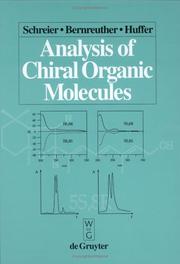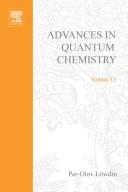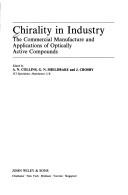| Listing 1 - 10 of 26 | << page >> |
Sort by
|

ISBN: 3110867850 9783110867855 3110136597 9783110136593 Year: 2011 Publisher: Berlin Boston
Abstract | Keywords | Export | Availability | Bookmark
 Loading...
Loading...Choose an application
- Reference Manager
- EndNote
- RefWorks (Direct export to RefWorks)
Optical isomers --- Chirality. --- Stereochemistry --- Symmetry (Physics) --- Enantiomers --- Isomers, Optical --- Isomers, Optically active --- Optically active isomers --- Stereoisomers --- Analysis.
Book
ISBN: 3030786757 9783030786755 3030786749 Year: 2021 Publisher: Cham, Switzerland : Springer,
Abstract | Keywords | Export | Availability | Bookmark
 Loading...
Loading...Choose an application
- Reference Manager
- EndNote
- RefWorks (Direct export to RefWorks)
Nuclear isomers. --- Isomerism (Nuclear physics) --- Isomers, Nuclear --- Isomers (Nuclear physics) --- Nuclear physics --- Nuclides --- Research. --- Nuclear research
Book
ISBN: 9811674302 9811674310 Year: 2022 Publisher: Singapore : Springer,
Abstract | Keywords | Export | Availability | Bookmark
 Loading...
Loading...Choose an application
- Reference Manager
- EndNote
- RefWorks (Direct export to RefWorks)
Supramolecular chemistry. --- Chirality. --- Enantiomers. --- Chemistry, Physical and theoretical --- Macromolecules --- Antipodes, Optical --- Enantiomorphs --- Isomers, Mirror-image --- Mirror-image isomers --- Optical antipodes --- Optical isomers --- Chirality --- Stereochemistry --- Symmetry (Physics) --- Enantiomers
Book
ISBN: 0387559027 3540559027 3540473084 9783540559023 Year: 1993 Volume: 166 Publisher: Berlin : Springer-Verlag,
Abstract | Keywords | Export | Availability | Bookmark
 Loading...
Loading...Choose an application
- Reference Manager
- EndNote
- RefWorks (Direct export to RefWorks)
Chemistry --- Chimie --- Data processing --- Informatique --- Aromaticity --- Isomerism and isomers --- Synthesis
Book
ISBN: 0751401900 9780751401905 Year: 1994 Publisher: London : Blackie,
Abstract | Keywords | Export | Availability | Bookmark
 Loading...
Loading...Choose an application
- Reference Manager
- EndNote
- RefWorks (Direct export to RefWorks)
544.12 --- Chemistry --- Asymmetric synthesis --- Isomerism and isomers, optical --- Stereochemistry

ISBN: 0120348136 9786611735890 1281735892 0080582389 Year: 1981 Publisher: New York, NY ; London : Academic Press,
Abstract | Keywords | Export | Availability | Bookmark
 Loading...
Loading...Choose an application
- Reference Manager
- EndNote
- RefWorks (Direct export to RefWorks)
Graph theory. --- Molecular orbitals. --- Electron affinity --- Ionization potential and energy --- Isomerism and isomers --- Wave function
Book
ISBN: 012803789X 0128037393 9780128037898 9780128037393 Year: 2018 Publisher: London, [England] : Academic Press,
Abstract | Keywords | Export | Availability | Bookmark
 Loading...
Loading...Choose an application
- Reference Manager
- EndNote
- RefWorks (Direct export to RefWorks)
Stereochemistry. --- Diastereoisomers. --- Diastereomers --- Optical isomers --- Atoms --- Molecular asymmetry --- Chemical structure --- Chemistry --- Isomerism --- Polarization (Light) --- Space arrangement

ISBN: 0471935956 0471966800 0471963135 9780471935957 9780471963134 Year: 1992 Publisher: Chichester : Wiley,
Abstract | Keywords | Export | Availability | Bookmark
 Loading...
Loading...Choose an application
- Reference Manager
- EndNote
- RefWorks (Direct export to RefWorks)
Chirality --- Enantiomers --- Enantoimers --- Chiralité --- Biotechnology --- Separation --- Chirality. --- Separation. --- Biotechnology. --- 544.122.3 --- Antipodes, Optical --- Enantiomorphs --- Isomers, Mirror-image --- Mirror-image isomers --- Optical antipodes --- Optical isomers --- Stereochemistry --- Symmetry (Physics) --- Amino acids --- industry --- Séparation --- Separating --- Production --- Chemical synthesis --- epoxy compounds --- Aminotransferases --- Aspartame --- Phospholipids --- Biocatalysts --- Chiralité --- Separating. --- Enantiomers - Separation. --- Enantiomers - Biotechnology. --- Enantiomers - Separation --- Enantiomers - Biotechnology --- Materiau optiquement pur --- Chiralite --- Captopril --- Beta-lactame --- Mentho --- Enantiomere
Book
ISBN: 012417115X 012417034X 9780124170346 Year: 2014 Publisher: Waltham, [Massachusetts] ; Amsterdam, The Netherlands : Academic Press,
Abstract | Keywords | Export | Availability | Bookmark
 Loading...
Loading...Choose an application
- Reference Manager
- EndNote
- RefWorks (Direct export to RefWorks)
Key Chiral Auxiliary Applications, Second Edition is a detailed compilation of chiral auxiliary applications organized by type of transformation. Continuing from the most important and relevant auxiliaries described in its predecessor, the three-volume set Compendium of Chiral Auxiliary Applications (2001), as well as advances in the field, the book provides a vital and timely resource for chemists in the field. Each reaction class includes a series of tables and graphical abstracts of real reactions from the literature and patents to enable easy review and comparison of resul
Asymmetric synthesis. --- Enantiomers. --- Enantioselective catalysis. --- Asymmetric synthesis --- Enantiomers --- Chemistry --- Physical Sciences & Mathematics --- Organic Chemistry --- Antipodes, Optical --- Enantiomorphs --- Isomers, Mirror-image --- Mirror-image isomers --- Optical antipodes --- Optical isomers --- Chirality --- Chiral catalysis --- Enantioselective heterogeneous catalysis --- Heterogeneous asymmetric catalysis --- Heterogeneous catalysis --- Asymmetric induction --- Induction, Asymmetric --- Synthesis, Asymmetric --- Asymmetry (Chemistry) --- Organic compounds --- Synthesis
Book
ISBN: 3319271814 3319271830 Year: 2016 Publisher: Cham : Springer International Publishing : Imprint: Springer,
Abstract | Keywords | Export | Availability | Bookmark
 Loading...
Loading...Choose an application
- Reference Manager
- EndNote
- RefWorks (Direct export to RefWorks)
This work focuses on new electromagnetic decay mode in nuclear physics. The first part of the thesis presents the observation of the two-photon decay for a transition where the one-photon decay is allowed. In the second part, so called quadrupole mixed-symmetry is investigated in inelastic proton scattering experiments. In 1930 Nobel-prize winner M. Goeppert-Mayer was the first to discuss the two-photon decay of an exited state in her doctoral thesis. This process has been observed many times in atomic physics. However in nuclear physics data is sparse. Here this decay mode has only been observed for the special case of a transition between nuclear states with spin and parity quantum number 0+. For such a transition, the one-photon decay – the main experimental obstacle to observe the two-photon decay – is forbidden. Furthermore, the energy sharing and angular distributions were measured, allowing conclusions to be drawn about the multipoles contributing to the two-photon transition. Quadrupole mixed-symmetry states are an excitation mode in spherical nuclei which are sensitive to the strength of the quadrupole residual interaction. A new signature for these interesting states is presented which allows identification of mixed-symmetry states independently of electromagnetic transition strengths. Furthermore this signature represents a valuable additional observable to test model predictions for mixed-symmetry states.
Nuclear Physics --- Electricity & Magnetism --- Physics --- Physical Sciences & Mathematics --- Photons --- Radioactive decay. --- Nuclear isomers. --- Scattering. --- Isomerism (Nuclear physics) --- Isomers, Nuclear --- Isomers (Nuclear physics) --- Decay, Radioactive --- Radioactive disintegration --- Nuclear physics --- Nuclides --- Half-life (Nuclear physics) --- Nuclear reactions --- Radioactivity --- Scattering (Physics) --- Nuclear physics. --- Nuclear Physics, Heavy Ions, Hadrons. --- Theoretical, Mathematical and Computational Physics. --- Atomic nuclei --- Atoms, Nuclei of --- Nucleus of the atom --- Heavy ions. --- Mathematical physics. --- Physical mathematics --- Ions --- Mathematics
| Listing 1 - 10 of 26 | << page >> |
Sort by
|

 Search
Search Feedback
Feedback About UniCat
About UniCat  Help
Help News
News